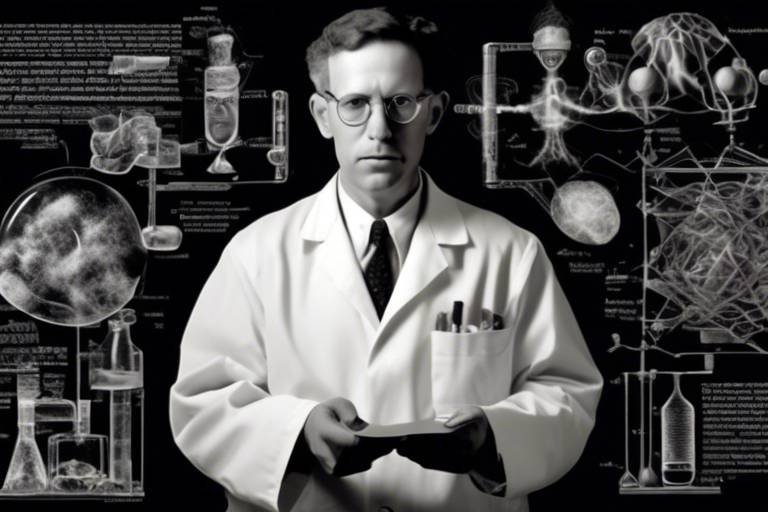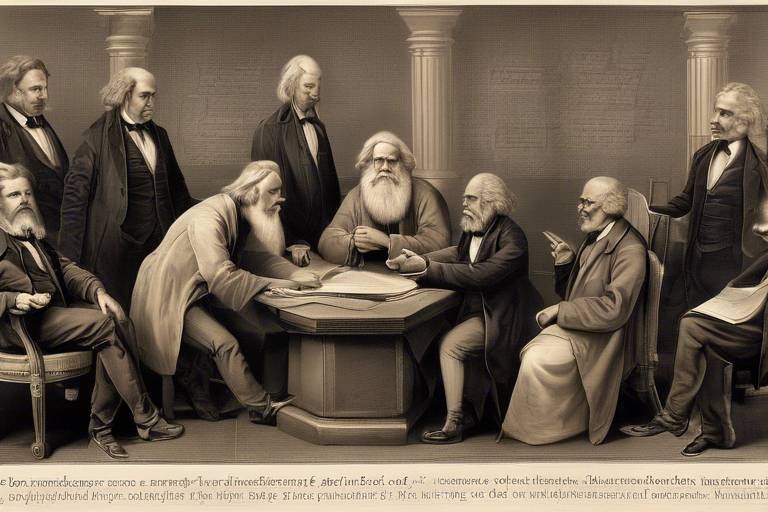Can Idealism and Materialism Coexist in Science?
In the vast realm of scientific exploration, two philosophical giants often clash: idealism and materialism. But can these two seemingly opposing views actually find a way to coexist? This question is not just a philosophical exercise; it has profound implications for how we understand the universe and our place within it. Imagine standing at the edge of a vast ocean, where the waves of thought crash against the shore of reality. On one side, you have the idealists, who believe that the mind shapes the world around us, while on the other side, the materialists assert that only physical matter truly exists. The interplay between these perspectives can lead to a richer, more nuanced understanding of scientific phenomena, but it also raises questions about the nature of reality itself.
At first glance, idealism and materialism may appear to be locked in a perpetual battle, each trying to undermine the other. However, when we dig deeper, we find that both philosophies offer valuable insights that can enhance our scientific inquiries. For instance, consider how quantum mechanics has challenged traditional materialist views. In the quantum realm, the act of observation seems to influence the behavior of particles, suggesting that consciousness plays a role in shaping reality. This perspective aligns more with idealist thought, yet it does not negate the materialist framework that provides the tools for measurement and experimentation. So, can we bridge the gap between these two philosophies? The answer may lie in recognizing that both idealism and materialism can contribute to a more holistic understanding of science.
In this article, we will explore the philosophical foundations of both idealism and materialism, their historical contexts, and how they can inform and enrich scientific research. By examining case studies and interdisciplinary approaches, we will uncover the potential for these two worldviews to not only coexist but also complement each other in the pursuit of knowledge. As we navigate this complex landscape, we invite you to ponder: what if the true essence of science lies not in choosing one philosophy over the other, but in embracing the strengths of both?
- What is idealism in science? Idealism is the philosophical belief that reality is fundamentally mental or immaterial, suggesting that our perceptions shape the world around us.
- What is materialism in science? Materialism posits that physical matter is the only reality, emphasizing that everything can be explained through physical processes and properties.
- Can idealism and materialism work together? Yes, by integrating both perspectives, scientists can gain a more comprehensive understanding of complex phenomena, leading to innovative solutions and deeper insights.
- How has quantum mechanics influenced the debate? Quantum mechanics challenges traditional materialist views by demonstrating that observation affects the behavior of particles, suggesting a role for consciousness in shaping reality.

The Philosophical Foundations of Idealism
At its core, idealism presents a fascinating perspective on reality, suggesting that the universe is fundamentally shaped by mental constructs rather than mere physical matter. This philosophical stance posits that our perceptions, thoughts, and consciousness play a pivotal role in shaping what we understand as reality. Imagine a painter creating a masterpiece; the canvas is blank, but the artist’s vision, emotions, and thoughts breathe life into it. Similarly, idealism asserts that the universe is like that canvas, waiting for our consciousness to give it form and meaning.
The roots of idealism can be traced back to ancient philosophical traditions, but it gained significant traction during the Enlightenment and Romantic periods. Thinkers such as George Berkeley and G.W.F. Hegel were instrumental in developing and popularizing idealist thought. Berkeley famously argued that "to be is to be perceived," emphasizing that reality is dependent on our perception of it. This radical idea challenges the notion of an independent material world, suggesting instead that reality is a tapestry woven from our collective experiences and consciousness.
As idealism evolved, it began to intersect with various scientific paradigms, particularly in fields such as quantum mechanics. Here, the role of the observer becomes crucial; the act of observation itself can influence the behavior of particles. This phenomenon can be likened to a magician performing a trick—what you see is not always what is happening behind the scenes. This interplay between observation and reality raises profound questions about the nature of existence and the limits of human understanding.
In exploring the philosophical foundations of idealism, it’s essential to recognize its implications for scientific inquiry. Idealism encourages a more holistic approach, urging scientists to consider not just the material aspects of their studies but also the mental frameworks through which they interpret data. This perspective can lead to richer, more nuanced understandings of complex phenomena, fostering an environment where creativity and intuition are valued alongside empirical evidence.
Moreover, idealism invites us to ponder the interconnectedness of all things. Just as a single thread can affect the entire fabric of a tapestry, our thoughts and beliefs can ripple through the universe, influencing the reality we experience. This idea challenges the rigid boundaries often established between disciplines, suggesting that philosophy, science, and spirituality can coexist and inform one another in meaningful ways.
In summary, the philosophical foundations of idealism provide a compelling framework for understanding not only our perceptions of reality but also the very nature of existence itself. By embracing this perspective, we can cultivate a deeper appreciation for the complexities of the universe and the role of human consciousness in shaping our understanding of it.

The Philosophical Foundations of Materialism
Materialism, at its core, is the philosophical stance that asserts that physical matter is the only reality. This perspective has been pivotal in shaping scientific inquiry and methodologies, as it emphasizes the tangible, observable aspects of the universe. Unlike idealism, which posits that reality is fundamentally mental or immaterial, materialism grounds itself in the physical world. This difference sets the stage for a rich dialogue between the two philosophies, especially in the context of scientific exploration.
The roots of materialism can be traced back to ancient philosophies, where thinkers like Democritus and Epicurus laid the groundwork for understanding the universe through the lens of matter and atomic theory. They proposed that everything in existence is composed of small, indivisible particles, a concept that resonates with modern scientific thought. Over the centuries, materialism evolved, influenced by various cultural and intellectual movements, leading to its establishment as a dominant paradigm in contemporary science.
In the modern era, materialism has undergone significant transformation, particularly through the influence of scientific advancements. The rise of disciplines such as physics and biology has reinforced the materialist viewpoint, emphasizing that all phenomena can be explained through physical processes and interactions. For instance, the development of Newtonian physics and later quantum mechanics has provided robust frameworks for understanding the material world, further solidifying the materialist foundation.
One of the defining characteristics of materialism is its focus on empirical evidence. Materialists believe that knowledge must be derived from observation and experimentation, which aligns closely with the scientific method. This empirical approach has led to significant breakthroughs in various fields, including medicine, technology, and environmental science. By prioritizing the material aspects of reality, scientists have been able to develop theories and technologies that have transformed our understanding of the world.
However, materialism is not without its criticisms. Some argue that it fails to account for the subjective aspects of human experience, such as consciousness, emotions, and values. This critique has led to ongoing debates within philosophical and scientific communities about the limitations of a strictly materialist view. Despite these challenges, materialism continues to be a powerful lens through which we examine and interpret the universe.
In summary, the philosophical foundations of materialism provide a crucial framework for understanding the physical world. It emphasizes the importance of matter and empirical evidence in our quest for knowledge, shaping the methodologies and inquiries that define modern science. As we explore the interplay between idealism and materialism, it becomes clear that both philosophies offer valuable insights into the complexities of existence, inviting a deeper examination of how we perceive and understand reality.
- What is materialism? Materialism is the philosophical belief that only physical matter exists and that everything can be explained through physical processes.
- How does materialism differ from idealism? Materialism focuses on the physical world, while idealism posits that reality is fundamentally mental or immaterial.
- What are some historical figures associated with materialism? Key figures include Democritus, Epicurus, and Karl Marx, who contributed to the development of materialist thought.
- Why is empirical evidence important in materialism? Empirical evidence is crucial because materialists believe that knowledge should be based on observation and experimentation.

Historical Context of Idealism
To truly grasp the essence of idealism, we must first journey through its historical context. Idealism, as a philosophical doctrine, asserts that reality is fundamentally shaped by the mind and its perceptions rather than existing independently in the material world. This notion has evolved over centuries, influenced by various thinkers and cultural movements. The roots of idealism can be traced back to ancient philosophies, but it gained significant traction during the Enlightenment, a period marked by a surge in intellectual exploration and a questioning of traditional beliefs.
During the Enlightenment, philosophers such as Immanuel Kant began to articulate the idea that our understanding of the world is mediated by our experiences and perceptions. Kant's work, particularly in his "Critique of Pure Reason," emphasized that while there is a reality outside our minds, we can only know it through our mental frameworks. This pivotal shift laid the groundwork for later idealist thinkers, who further explored the implications of this perspective.
In the 19th century, idealism was championed by philosophers like Georg Wilhelm Friedrich Hegel, who proposed that reality is a manifestation of a rational process unfolding through history. Hegel's dialectical method suggested that contradictions in ideas lead to a higher synthesis, promoting a dynamic view of reality that resonated deeply within scientific discourse. His influence extended beyond philosophy, impacting fields such as politics, art, and science.
As we move into the 20th century, the emergence of quantum mechanics brought idealist thought back into the spotlight. The peculiar behaviors of subatomic particles challenged the materialist interpretations of reality. Notably, physicists like Niels Bohr and Werner Heisenberg hinted at the role of the observer in determining the state of a particle, suggesting that consciousness and perception are integral to understanding the universe. This intersection of idealism and science continues to provoke thought and debate among scholars and scientists alike.
In summary, the historical context of idealism reveals a rich tapestry of ideas and influences that have shaped its evolution. From the Enlightenment to modern quantum physics, idealism's journey reflects humanity's ongoing quest to understand the nature of reality. As we explore the interplay between idealism and materialism, it becomes evident that these philosophies, while seemingly opposing, can offer complementary insights into the profound mysteries of existence.

Key Figures in Idealist Philosophy
When we delve into the realm of idealist philosophy, it's impossible to overlook the monumental contributions of several key figures who have shaped its trajectory. These thinkers have not only influenced the philosophical landscape but have also left an indelible mark on the scientific discourse of their times. Let's explore some of the most significant names in idealism and how their ideas resonate within both philosophical and scientific contexts.
One of the most prominent figures is George Berkeley, an Irish philosopher who famously asserted that "to be is to be perceived." Berkeley challenged the notion of material existence independent of perception, arguing that reality is fundamentally tied to the observer's mind. His ideas paved the way for a deeper understanding of perception and reality, influencing later scientific theories that explore the nature of consciousness and observation.
Another key figure is G.W.F. Hegel, whose dialectical method emphasized the importance of ideas and their development through contradictions and resolutions. Hegel's work on the nature of reality as a dynamic process influenced various fields, including social science and political theory, but also extended into the scientific realm by prompting thinkers to consider the evolving nature of scientific paradigms.
In addition to Berkeley and Hegel, we must consider Immanuel Kant, who sought to reconcile empiricism and rationalism. Kant introduced the idea that our understanding of the world is shaped by both sensory experiences and innate concepts. His notion of the categorical imperative and the limits of human understanding have profound implications for scientific inquiry, particularly in how we frame questions and interpret data.
These philosophers, among others, have laid the groundwork for idealist thought, which continues to influence contemporary discussions in both philosophy and science. Their ideas remind us that reality is not just a collection of material objects but also a tapestry woven from perception, thought, and consciousness.
As we reflect on their contributions, it's essential to recognize that idealism is not merely an abstract concept but a lens through which we can explore the complexities of existence. The interplay between perception and reality is a theme that resonates in modern scientific debates, particularly in fields like quantum mechanics, where the observer effect challenges traditional notions of objectivity.
In summary, the key figures in idealist philosophy have provided us with invaluable insights into the nature of reality, perception, and consciousness. Their legacies continue to inspire both philosophical and scientific exploration, highlighting the importance of considering multiple perspectives in our quest for understanding.
- What is idealism in philosophy? Idealism is the belief that reality is fundamentally mental or immaterial, emphasizing the role of the mind in shaping our understanding of the world.
- Who are the main proponents of idealism? Key figures include George Berkeley, G.W.F. Hegel, and Immanuel Kant, each contributing unique perspectives that have influenced both philosophy and science.
- How does idealism relate to modern science? Idealism challenges conventional scientific views, particularly in fields like quantum mechanics, where the observer's role is crucial to understanding reality.
- Can idealism and materialism coexist? Yes, many argue that these philosophies can complement each other, providing a more comprehensive understanding of complex phenomena in science.

Impact of Idealism on Modern Science
Idealism, while often seen as a philosophical stance that contrasts sharply with materialism, has made profound contributions to modern science. At its core, idealism argues that the mind and consciousness play a critical role in shaping reality. This perspective has been instrumental in fields such as quantum mechanics, where the act of observation fundamentally alters the state of a particle. In this way, idealism challenges the traditional materialist view that reality exists independently of our perceptions.
One of the most notable impacts of idealism on modern science can be seen in the interpretation of quantum phenomena. For instance, the famous double-slit experiment showcases how particles behave differently when observed. When unobserved, particles exhibit wave-like behavior, but upon observation, they behave like particles. This paradox raises questions about the role of consciousness in defining reality, suggesting that our mental processes are not merely passive observers but active participants in the unfolding of the universe.
Moreover, idealism has influenced various scientific theories and practices beyond quantum physics. In fields like psychology and cognitive science, the exploration of consciousness and subjective experience has led to groundbreaking research on how our thoughts and beliefs shape our understanding of the world. The idea that our mental frameworks can influence our interpretations of reality has important implications for scientific inquiry. For example, researchers are increasingly recognizing the need to account for subjective experiences in experimental designs, thereby integrating idealist perspectives into empirical research.
Furthermore, the impact of idealism is also evident in the realm of theoretical physics. Concepts such as string theory and the multiverse hypothesis often challenge conventional materialist views by proposing realities beyond our immediate perception. These theories suggest that the universe may be far more complex than what can be measured or observed, hinting at a deeper, interconnected reality that resonates with idealist thought. In this sense, idealism encourages scientists to think outside the box, fostering creativity and innovation in their approaches to understanding the cosmos.
In addition to its theoretical implications, idealism has practical impacts on scientific collaboration and interdisciplinary research. By embracing a more holistic view that acknowledges the interplay between mind and matter, scientists from various fields can work together to tackle complex problems. For instance, the integration of psychological insights into environmental science has led to more effective strategies for addressing climate change, emphasizing the importance of human perception and behavior in ecological sustainability.
In conclusion, the influence of idealism on modern science is both profound and multifaceted. By challenging the assumptions of materialism and emphasizing the significance of consciousness, idealism not only enriches our understanding of scientific phenomena but also encourages a more collaborative and innovative approach to research. As we continue to explore the mysteries of the universe, the dialogue between idealism and materialism will undoubtedly play a crucial role in shaping the future of scientific inquiry.
- What is the main difference between idealism and materialism?
Idealism posits that reality is fundamentally mental or immaterial, while materialism asserts that only physical matter exists and that everything can be explained through physical processes. - How does idealism influence scientific research?
Idealism encourages scientists to consider the role of consciousness and perception in their studies, leading to more holistic approaches and innovative solutions to complex problems. - Can idealism and materialism coexist in scientific discourse?
Yes, many scientists believe that integrating both perspectives can lead to a richer understanding of the universe, as each philosophy offers valuable insights that can complement the other. - What are some examples of idealism in modern science?
Examples include the implications of the double-slit experiment in quantum mechanics, the study of consciousness in psychology, and the theoretical frameworks in physics like string theory.

Historical Context of Materialism
To truly grasp the essence of materialism, we must journey through its rich and varied historical landscape. Materialism, at its core, asserts that the physical world is the only reality, a viewpoint that has evolved significantly over centuries. From its ancient roots to its modern interpretations, materialism has profoundly influenced scientific thought and inquiry.
The origins of materialism can be traced back to ancient philosophers such as Democritus and Epicurus, who proposed that everything in the universe is composed of small, indivisible particles known as atoms. This early form of materialism emphasized the importance of physical matter and natural laws, challenging the prevailing mythological and spiritual explanations of the world. As we move through history, we encounter the Enlightenment period, which further propelled materialist ideas into the limelight. Thinkers like Thomas Hobbes and John Locke laid the groundwork for modern materialism by advocating for a rational, empirical approach to understanding reality.
In the 19th century, materialism underwent a significant transformation with the advent of scientific materialism. This movement was characterized by a strong reliance on empirical evidence and the scientific method. Figures such as Karl Marx and Friedrich Engels expanded materialism beyond the realm of physical existence to include social and economic dimensions, leading to what is now known as dialectical materialism. This perspective emphasized the material conditions of life as the foundation for societal development and human consciousness.
As we entered the 20th century, the rise of natural sciences further solidified materialism's position in scientific discourse. The development of theories such as relativity and quantum mechanics challenged traditional notions of materialism but did not displace it. Instead, these theories prompted a reevaluation of materialist principles, leading to a more nuanced understanding of matter and reality. For instance, quantum mechanics introduced the idea that particles can exist in multiple states simultaneously, raising questions about the nature of reality that materialism must address.
Today, materialism continues to be a dominant force in scientific inquiry, shaping methodologies and frameworks across various disciplines. However, it is essential to recognize that the dialogue between materialism and other philosophical perspectives, such as idealism, remains vibrant and complex. The interplay between these philosophies not only enriches our understanding of the universe but also underscores the importance of an interdisciplinary approach to knowledge.
In summary, the historical context of materialism reveals a rich tapestry of ideas and developments that have shaped our understanding of reality. From ancient atomists to contemporary scientific advancements, materialism's evolution reflects a continuous quest for knowledge grounded in the physical world. As we navigate the complexities of modern science, the legacy of materialism serves as a reminder of the enduring power of empirical inquiry and the significance of philosophical discourse in shaping our understanding of existence.
- What is materialism? Materialism is the philosophical viewpoint that physical matter is the only reality, and everything can be explained in terms of physical processes and interactions.
- How does materialism differ from idealism? While materialism focuses on the physical world, idealism posits that reality is fundamentally mental or immaterial, emphasizing the role of consciousness and perception.
- Can materialism and idealism coexist? Yes, many scholars argue that materialism and idealism can complement each other, providing a more comprehensive understanding of complex phenomena in science.
- Who are some key figures in the history of materialism? Key figures include Democritus, Epicurus, Karl Marx, and Friedrich Engels, each contributing to the evolution of materialist thought.

Conflict and Complementarity in Science
The relationship between idealism and materialism in science is often perceived as a battleground of opposing ideas. On one side, idealism champions the notion that the mind and its perceptions shape reality, while materialism firmly stands on the premise that only physical matter constitutes true existence. This dichotomy can lead to fierce debates, but it also opens up a fascinating dialogue that can enrich our understanding of the universe. Isn't it intriguing how two seemingly conflicting philosophies can actually inform and enhance one another in scientific discourse?
At first glance, it may seem that idealism and materialism are incompatible, much like oil and water. However, when we dive deeper, we find that they can actually complement each other, much like two sides of the same coin. For instance, in the realm of quantum mechanics, idealist perspectives challenge traditional materialist views by suggesting that consciousness plays a crucial role in the behavior of particles. This interplay has led to groundbreaking theories and experiments that are reshaping our understanding of reality.
Moreover, the conflict between these two philosophies can spur innovation. When scientists are faced with contrasting viewpoints, they are often pushed to think outside the box and explore new avenues of research. This tension can lead to a more nuanced understanding of complex phenomena. Take, for instance, the debate on the nature of light. The wave-particle duality of light has puzzled scientists for centuries. Idealists argue that light's behavior is influenced by observation, whereas materialists maintain that it is purely a physical entity. This ongoing dialogue not only enriches scientific inquiry but also encourages interdisciplinary approaches that can lead to novel discoveries.
To illustrate this point, consider the following table that summarizes the main points of conflict and complementarity between idealism and materialism:
| Aspect | Idealism | Materialism |
|---|---|---|
| Definition | Reality is mental or immaterial | Only physical matter is real |
| Scientific Approach | Focus on consciousness and perception | Focus on empirical evidence and material phenomena |
| Examples in Science | Quantum mechanics, consciousness studies | Classical physics, neuroscience |
| Potential for Integration | Encourages holistic views | Promotes rigorous methodologies |
In conclusion, while idealism and materialism often clash, their conflict can lead to a richer understanding of scientific phenomena. By embracing both perspectives, scientists can cultivate a more comprehensive approach to inquiry. The future of science may very well depend on our ability to reconcile these philosophies, fostering a more inclusive dialogue that propels us toward new horizons of knowledge.
- Can idealism and materialism coexist in scientific research? Yes, both can coexist and often enrich each other, leading to a more comprehensive understanding of complex phenomena.
- How does quantum mechanics illustrate the conflict between idealism and materialism? Quantum mechanics suggests that observation may influence reality, which challenges traditional materialist views.
- What role does philosophical dialogue play in scientific advancement? Philosophical dialogue encourages innovative thinking and can lead to breakthroughs in understanding.

Case Studies in Scientific Research
The interplay between idealism and materialism in scientific research is not merely a theoretical debate; it manifests in real-world studies that shape our understanding of the universe. One fascinating example is the realm of quantum mechanics, where the observer effect illustrates how the act of observation can influence the behavior of particles. This phenomenon raises profound questions: Is the act of observation a material interaction, or does it imply a deeper, idealist perspective where consciousness plays a pivotal role? Such inquiries challenge the conventional materialist view that reality exists independently of our perceptions.
Another compelling case study lies in the field of neuroscience. Researchers are increasingly recognizing that our mental states—thoughts, emotions, and beliefs—can significantly impact physical health. For instance, studies have shown that positive mental attitudes can enhance immune function. This intersection of mind and body suggests that idealist notions about the primacy of mental states can enrich our understanding of material processes. Thus, rather than viewing idealism and materialism as conflicting paradigms, we can see them as complementary forces that together provide a more rounded picture of human experience.
In the realm of environmental science, idealist and materialist frameworks can also be observed in action. Consider the debate surrounding climate change. Materialists might emphasize the physical evidence—rising temperatures, melting ice caps, and increasing CO2 levels—while idealists might focus on the mental and cultural shifts necessary to address these issues. For example, community-led initiatives that change public perception and behavior regarding sustainability reflect an idealist approach that complements the materialist understanding of environmental data. This synergy highlights how integrating both perspectives can lead to innovative solutions for complex global challenges.
Moreover, psychological research offers another rich ground for exploration. Studies on the placebo effect reveal how belief and expectation can lead to tangible physical changes in health outcomes. This phenomenon challenges the strictly materialist view that only direct physical interventions can effect change. Instead, it underscores the importance of mental states and their power to influence material reality. By embracing both idealist and materialist perspectives, researchers can develop more effective therapeutic strategies that account for both mind and body.
To summarize, the case studies across various scientific fields illustrate that idealism and materialism are not mutually exclusive but rather interwoven threads in the fabric of scientific inquiry. By fostering a dialogue between these two philosophies, we can cultivate a richer understanding of the complexities of our world. The fusion of these perspectives can lead to breakthroughs that neither could achieve alone, ultimately enhancing our quest for knowledge and understanding.
- Can idealism and materialism be reconciled in scientific research?
Yes, many researchers find that integrating both perspectives can lead to a more comprehensive understanding of complex phenomena. - What are some examples of idealism influencing scientific thought?
Idealism has significantly impacted fields like quantum mechanics and neuroscience, where the observer's role and mental states are crucial. - How does the interplay between idealism and materialism affect environmental science?
Both philosophies contribute to our understanding of climate change, with materialism focusing on data and idealism emphasizing cultural shifts. - Is one philosophy more valid than the other in science?
Both idealism and materialism offer valuable insights, and their validity often depends on the context of the research being conducted.

Interdisciplinary Approaches
When we think about the realms of idealism and materialism, it’s easy to see them as opposing forces, like two rival teams on a field. However, what if these two philosophies could actually work together, like a well-coordinated dance? In the world of science, interdisciplinary approaches are proving to be the bridge that connects these seemingly disparate viewpoints, leading to innovative solutions and richer insights.
Imagine a scientist studying the intricacies of the human mind. On one hand, the materialist perspective focuses on the physical brain, neurons, and neurotransmitters, emphasizing that all mental processes can be traced back to biological functions. On the other hand, the idealist perspective might explore the implications of consciousness, perception, and subjective experience, suggesting that reality is shaped by our mental interpretations. By integrating these approaches, researchers can develop a more comprehensive understanding of phenomena such as consciousness, perception, and emotions.
Interdisciplinary approaches in science can manifest in various ways, including:
- Collaboration across fields: Scientists from psychology, neuroscience, and philosophy can come together to explore the depths of human experience.
- Cross-pollination of ideas: Insights from quantum physics, which often leans towards idealism, can inform materialist interpretations in biology and chemistry.
- Innovative methodologies: Utilizing techniques from both qualitative and quantitative research can provide a fuller picture of complex issues.
This fusion of ideas not only enriches scientific inquiry but also opens the door to new methodologies that can tackle the limitations inherent in a singular perspective. For example, the study of quantum mechanics has shown how observer effect—an idealist concept—can influence the behavior of particles. This has profound implications for both theoretical physics and practical applications in technology.
Furthermore, interdisciplinary approaches encourage scientists to ask different kinds of questions. Instead of simply seeking to understand how things work in isolation, they begin to explore why they work the way they do. This shift in perspective can lead to breakthroughs in fields like cognitive science, where understanding the interplay between the brain (materialism) and the mind (idealism) is crucial for advancements in artificial intelligence and mental health treatment.
Ultimately, the convergence of idealism and materialism through interdisciplinary approaches fosters a culture of innovation and creativity. By embracing both perspectives, scientists can navigate the complexities of the universe with a more nuanced lens, leading to discoveries that not only enhance our understanding but also improve our quality of life.
Q1: Can idealism and materialism really work together in science?
Yes! By combining insights from both philosophies, scientists can gain a more comprehensive understanding of complex phenomena.
Q2: What are some examples of interdisciplinary approaches?
Examples include collaborations between psychology and neuroscience, as well as the application of quantum physics concepts in biological research.
Q3: How does this integration benefit scientific research?
It opens up new avenues for inquiry, encourages innovative methodologies, and leads to a deeper understanding of the subjects being studied.

The Future of Idealism and Materialism in Science
As we gaze into the horizon of scientific inquiry, the question arises: can idealism and materialism truly coexist? The landscape of science is continually evolving, and with it, the philosophies that underpin our understanding of the universe. Idealism, which emphasizes the mental and immaterial aspects of reality, and materialism, which focuses solely on the physical, often seem at odds. Yet, the future may hold a surprising potential for these two perspectives to not only coexist but also to enrich one another.
Imagine a world where scientists embrace both idealist and materialist views, much like how a painter uses both light and shadow to create depth in a masterpiece. This dual approach could lead to groundbreaking discoveries that neither philosophy could achieve alone. For instance, consider the realm of quantum mechanics, where the observer effect suggests that the act of observation can alter the outcome of an experiment. Here, idealist principles challenge the materialist narrative, suggesting that consciousness plays a crucial role in shaping reality. As we delve deeper into such phenomena, the integration of both perspectives could pave the way for a more holistic understanding of the universe.
Moreover, the integration of these philosophies could foster a new wave of interdisciplinary collaboration. By drawing from the strengths of both idealism and materialism, scientists from various fields—such as physics, psychology, and even philosophy—can come together to tackle complex questions that have long eluded definitive answers. For example, the study of consciousness itself is a prime candidate for this collaborative approach. Materialist perspectives may focus on the neurological underpinnings of consciousness, while idealist views might explore the subjective experience of being aware. Together, these insights could lead to a richer understanding of what it means to be conscious.
As we advance into an era defined by rapid technological progress, the role of philosophy in science cannot be overstated. The dialogue between idealism and materialism will be essential in guiding ethical considerations in scientific research, particularly in areas like artificial intelligence and biotechnology. Questions about the nature of life, consciousness, and the implications of creating sentient beings will require a philosophical framework that incorporates both perspectives. As scientists grapple with these profound ethical dilemmas, the potential for idealism and materialism to inform one another becomes increasingly vital.
In conclusion, the future of science may very well depend on our ability to harmonize idealist and materialist philosophies. By fostering a dialogue that embraces both perspectives, we can unlock new avenues of understanding that challenge the boundaries of traditional scientific inquiry. As we navigate this complex landscape, let’s remain open to the possibilities that arise when we allow these seemingly opposing views to coexist. The universe is vast and intricate, and perhaps our understanding of it should be too.
- Can idealism and materialism be integrated in scientific research?
Yes, integrating both philosophies can lead to a more comprehensive understanding of complex phenomena. - What role does consciousness play in the relationship between idealism and materialism?
Consciousness is a key area where both perspectives can inform each other, particularly in fields like quantum mechanics and the study of awareness. - How can interdisciplinary collaboration benefit from the coexistence of these philosophies?
Collaboration can foster innovative solutions to complex scientific questions, drawing on the strengths of both idealism and materialism.
Frequently Asked Questions
- What is the main difference between idealism and materialism?
Idealism suggests that reality is fundamentally mental or immaterial, focusing on the mind's role in shaping our understanding of the universe. In contrast, materialism asserts that only physical matter exists, emphasizing the importance of tangible, observable phenomena in scientific inquiry.
- Can idealism and materialism coexist in scientific discourse?
Yes, idealism and materialism can coexist in scientific discourse. While they often appear to be in conflict, these philosophies can complement each other by providing a more holistic understanding of complex phenomena. Integrating both perspectives can lead to innovative solutions and deeper insights.
- How has idealism influenced modern scientific fields?
Idealism has significantly impacted various scientific fields, especially in quantum mechanics. It challenges conventional views by suggesting that the observer plays a crucial role in the measurement process, prompting scientists to reconsider the relationship between consciousness and reality.
- Who are some key figures in idealist philosophy?
Notable figures in idealist philosophy include George Berkeley, who argued that existence is dependent on perception, and G.W.F. Hegel, who emphasized the development of ideas through dialectical processes. Their contributions have shaped how idealism is understood and applied in scientific contexts.
- What historical developments have shaped materialism?
Materialism has evolved from ancient philosophies, such as those of Democritus and Epicurus, to contemporary thought influenced by scientific advancements. This evolution highlights materialism's role in shaping modern scientific methodologies and understanding of the universe.
- Are there specific case studies that illustrate the interplay between idealism and materialism?
Yes, various case studies demonstrate how idealist and materialist perspectives can inform scientific research. For instance, studies in quantum physics often reveal how observer effects challenge traditional materialist views, encouraging a dialogue between the two philosophies.
- What is the future of idealism and materialism in science?
The future of idealism and materialism in science looks promising, with increasing recognition of the need for philosophical dialogue. By fostering cooperation between these two viewpoints, scientists can advance knowledge and explore the complexities of the universe more comprehensively.



















